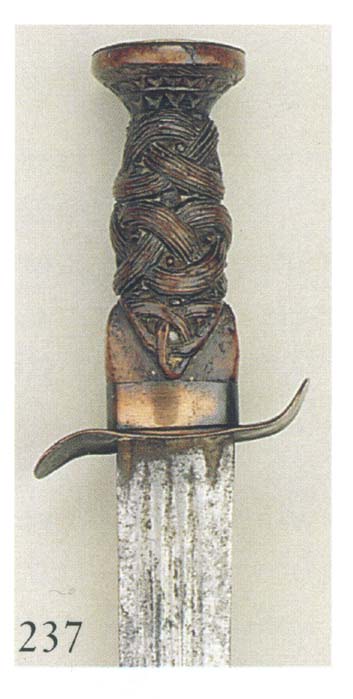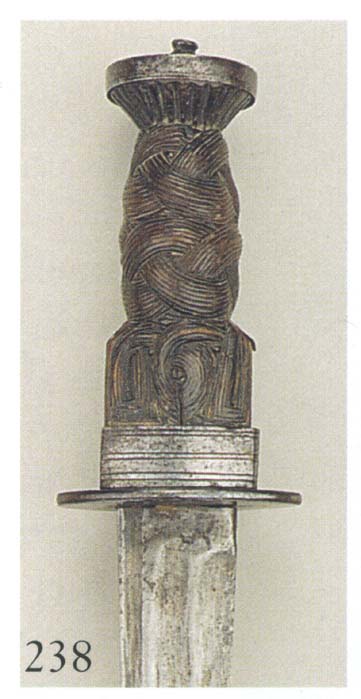Hi folks...
I've been asked by a customer to make a scottish-style dirk blade with rondel guards. I have not been able to find references to these... but have been told they did indeed exist.
Any ideas?
I don't know what a "Scottish dirk blade" would be... a Scottish dirk is the whole weapon, not simply the blade. Scottish dirks are extremely varied as far as blade shapes and styles.
Have you read our spotlight article on the rondel dagger? A dagger with rondels is a rondel dagger. Simple as that. Like the Scottish Dirk, there is a lot of variety to be found as far as blade properties.
Both spotlights linked in this post.
Have you read our spotlight article on the rondel dagger? A dagger with rondels is a rondel dagger. Simple as that. Like the Scottish Dirk, there is a lot of variety to be found as far as blade properties.
Both spotlights linked in this post.
| Nathan Robinson wrote: |
| I don't know what a "Scottish dirk blade" would be... a Scottish dirk is the whole weapon, not simply the blade. Scottish dirks are extremely varied as far as blade shapes and styles.
Have you read our spotlight article on the rondel dagger? A dagger with rondels is a rondel dagger. Simple as that. Like the Scottish Dirk, there is a lot of variety to be found as far as blade properties. Both spotlights linked in this post. |
Well... Scottish dirks do have a characteristic blade it seems to me. That is all I (my customer) meant I believe. A blade similar to what you would find on a dirk.. except with rondel fittings.
I have read both spotlight articles as well as looked into other rondels.. and it seems that most of these have thicker blade profiles and are almost exclusively for thrusting. Whereas a dirk blade seems to have cutting ability as well... at least more so than a rondel.
I think the point is this: A knife in a Scottish setting carried and used like a dirk... with a blade that is typical of a dirk.. but with discoid fittings. I've spoken with two people who have seen examples of this in a Scottish context.. but neither can find their references. I'm open the possibility that this doesn't exist in a meaningful way. It's more my own curiosity.. the customer wants this regardless.
(also.. it seems that the variation with 'Scottish dirks' is inherent only if you include ballock daggers and dudgeons. He wants the nearly triangular shaped blade typical of 'early dirks' and 'dirks'... which all the examples in the article you referenced bear)
Scottish Dirks have a great variety to the blade shapes, lengths, geometries, and other characteristics. They are found fullered, non-fullered--and when fullered, can be seen with a great variety to the number and pattern of fullers. They are single edged, occasionally double-edged, and often with a false edge. They can be found with cut-down sword blades and that opens up a whole other degree of diversity. Some might be found with gimping on their spine, others not. Some might have a "fuller" running down the spine, some are left completely blank. Some might have a shaped spine (like a "T") while others won't. Some blade geometries might be a wedge-shape, others with more parallel faces and a thick edge, while others might have a concave shape. Some blades might be extremely thick, while others might be shockingly thin. Re-inforced points can be found on dirk blades--or not. Ricassos can be found on dirk blades--or not.
The form called a "Scottish dirk" is a description of the entire weapon, not the blade.
Just as much diversity--no, even more--can be found on rondel daggers. Examples are found that are thrust-only, cut-oriented, or a combination of both. Examples that have blades with all kinds of variety to their fullers can be found, as can non-fullered blades. Blah blah blah... you get the idea.
Sounds like your client just wants a rondel dagger with a single-edged blade and a sharp tip. Sounds fair. There's example like that... a couple are in the spotlight even (which only shows a tiny, tiny bit of what is out there...)
Here are some photos of some replica drinks that closely match originals. The blades of these three are extremely dissimilar to each other. One has a wedge-shaped blade with a spine that is 5/16" thick at its base (!) with a sharp false edge. Another has a very straight-edged blade with multiple fullers, a robust tip, and a false edge. The third has a very thin and more founded tip-section, a single shallow fuller, and a graceful curve to its edge.
[ Linked Image ]
[ Linked Image ]
[ Linked Image ]
The form called a "Scottish dirk" is a description of the entire weapon, not the blade.
Just as much diversity--no, even more--can be found on rondel daggers. Examples are found that are thrust-only, cut-oriented, or a combination of both. Examples that have blades with all kinds of variety to their fullers can be found, as can non-fullered blades. Blah blah blah... you get the idea.
Sounds like your client just wants a rondel dagger with a single-edged blade and a sharp tip. Sounds fair. There's example like that... a couple are in the spotlight even (which only shows a tiny, tiny bit of what is out there...)
Here are some photos of some replica drinks that closely match originals. The blades of these three are extremely dissimilar to each other. One has a wedge-shaped blade with a spine that is 5/16" thick at its base (!) with a sharp false edge. Another has a very straight-edged blade with multiple fullers, a robust tip, and a false edge. The third has a very thin and more founded tip-section, a single shallow fuller, and a graceful curve to its edge.
[ Linked Image ]
[ Linked Image ]
[ Linked Image ]
I wonder if the client was thinking of a few oddball dirks with plate guards (see below). But Nathan's right, there is no one form of dirk blade (nor ballock, nor rondel). Tons of variety.
 Attachment: 37.67 KB
Attachment: 37.67 KB

From an old Peter Finer catalogue, I believe.
 Attachment: 38.07 KB
Attachment: 38.07 KB

From an old Peter Finer catalogue, I believe.

From an old Peter Finer catalogue, I believe.

From an old Peter Finer catalogue, I believe.
Thank you Chad.. that is what I was looking for. I'm sure that is what he meant.
I completely understand that there is a variety in dirk blades... But I still can't help but see a characteristic in MOST dirk blades that scream dirk to me as a generality. Even in the examples Nathan has just shown. And it's not fullers and gimping and grind. I know there are variations... but I just can't help it! :-) A better argument (for me) is the rondel. There does seem to be a larger variation within that theme... even though I typically think of the thick, heavy spike-type or 'misericorde'. You are right.. he is probably thinking of a rondel.. even though those seem to be out of context with the persona he portrays as a Scottish Highlander.. with rondels being mostly 'knightly' daggers.
I completely understand that there is a variety in dirk blades... But I still can't help but see a characteristic in MOST dirk blades that scream dirk to me as a generality. Even in the examples Nathan has just shown. And it's not fullers and gimping and grind. I know there are variations... but I just can't help it! :-) A better argument (for me) is the rondel. There does seem to be a larger variation within that theme... even though I typically think of the thick, heavy spike-type or 'misericorde'. You are right.. he is probably thinking of a rondel.. even though those seem to be out of context with the persona he portrays as a Scottish Highlander.. with rondels being mostly 'knightly' daggers.
| Chad Arnow wrote: |
| I wonder if the client was thinking of a few oddball dirks with plate guards (see below). But Nathan's right, there is no one form of dirk blade (nor ballock, nor rondel). Tons of variety. |
Chad-
Perfect find. I was stuck on taking the question too literally: twin rondels and not the characteristic Scottish dirk grip. I wish the client would have asked about the strange Scottish dirks that had guard plates at the blade/hilt transition, because that's all that's going on there.
They certainly are oddball and I've wondered if those plates were added after the dirk's original manufacture; perhaps after a rehilt. I don't think I've seen this replicated before so that might be interesting to see!
Page 1 of 1
You cannot post new topics in this forumYou cannot reply to topics in this forum
You cannot edit your posts in this forum
You cannot delete your posts in this forum
You cannot vote in polls in this forum
You cannot attach files in this forum
You can download files in this forum
All contents © Copyright 2003-2006 myArmoury.com — All rights reserved
Discussion forums powered by phpBB © The phpBB Group
Switch to the Full-featured Version of the forum
Discussion forums powered by phpBB © The phpBB Group
Switch to the Full-featured Version of the forum